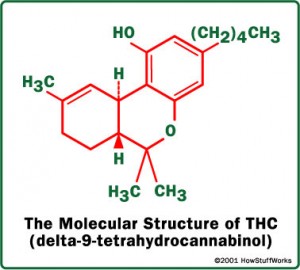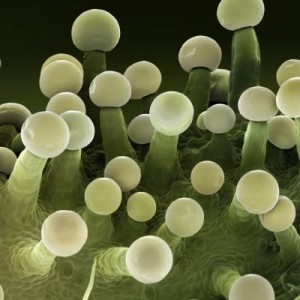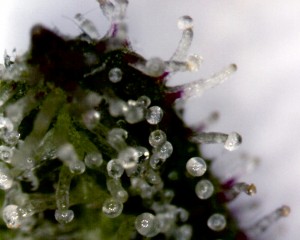 Cannabis is the only plant in the world that produces chemicals called cannabinoids. There are approximately 110+ identified cannabinoids that have been confirmed to exist and each of an infinite number of strains of marijuana chemistry has its cannabinoid profile.
Cannabis is the only plant in the world that produces chemicals called cannabinoids. There are approximately 110+ identified cannabinoids that have been confirmed to exist and each of an infinite number of strains of marijuana chemistry has its cannabinoid profile.
The active cannabinoids each have unique physiological effects and many combinations appear to have synergistic and antagonistic effects. Six (6) most prominent cannabinoids are:
- THC-9
- THC-8
- Cannabidiol (CBD)
- Cannabinol (CBN)
- Tetrahydrocannabivarin (THCV)
- Cannabichromene (CBC)
 THC-9 is the main ingredient in marijuana chemistry that gets you high and this compound is called trans-hydrocannabinol. No matter what type of cannabis, whether it is industrial hemp or medical marijuana chemistry contains some amount of THC-9.
THC-9 is the main ingredient in marijuana chemistry that gets you high and this compound is called trans-hydrocannabinol. No matter what type of cannabis, whether it is industrial hemp or medical marijuana chemistry contains some amount of THC-9.
Euphoric, stimulant, muscle relaxant, anti-epileptic, anti-emetic, anti-inflammatory, appetite-stimulating, broncho-dilating, hypotensive, anti-depressant, and analgesic effects come from THC-9. THC-8 is another type of cannabinoid that is found in very low concentrations of cannabis.
This compound gets you high as well, though there is much less within cannabis and both THC-9 and THC-8 are often referred to in general as THC. Cannabidiol or CBD shows itself in virtually all types of marijuana chemistry and the amounts vary from plant to plant.
Cannabidiol ranges from very small amounts to as much as 95 percent of all cannabinoids that are present within the marijuana chemistry.
Cannabidiol has a sedative effect that is present within the high you attain using marijuana and when combined with THC, tends to postpone or delay the beginning effects of the high.
The positive side is that cannabidiol increases the high, lasting up to twice the time as without it and it relieves convulsion, inflammation, anxiety, and nausea, and inhibits cancer cell growth.
Recent studies have shown cannabidiol to be as effective as atypical antipsychotics in treating schizophrenia. In November 2007 it was reported that CBD reduces the growth of aggressive human breast cancer cells in vitro and reduces their invasiveness.
It thus represents the first non-toxic exogenous agent that can lead to the down-regulation of tumor aggressiveness. It is also a neuroprotective antioxidant. It also lessens the psychoactive effects of THC have sedative and analgesic effects as well as cannabinol or CBN is produced when THC oxidizes or degrades.
Only very small amounts of CBN exist in the fresh bud so when it is stored and cured, the levels of cannabinol are increased, from the conversion from THC in its marijuana chemistry. A mildly psychoactive degradation of THC, its primary effects are as an anti-epileptic, and to lower intraocular pressure.
High levels of Cannabinol make the user disoriented and often sleepy or groggy, often known as “stupefied”.
Tetrahydrocannabivarin Cannabinoid
 Tetrahydrocannabivarin (THCV, THV), also known as tetrahydrocannabivarol, is the shorter three-carbon propyl that replaces the five-carbon pentyl chain in marijuana chemistry.
Tetrahydrocannabivarin (THCV, THV), also known as tetrahydrocannabivarol, is the shorter three-carbon propyl that replaces the five-carbon pentyl chain in marijuana chemistry.
This compound is what makes up the very essence or fragrance in the smell of marijuana and with warmer temperatures, the smell becomes more pungent.
Tetrahydrocannabivarin comes from potent plants coming from Africa and parts of Asia and it is a non-psychoactive cannabinoid found naturally in Cannabis sativa.
It is an analog of tetrahydrocannabinol (THC) with the side chain shortened by two CH2 groups. THCV can be used as a marker compound to differentiate between the consumption of hemp products and synthetic THC (e.g., Marinol).
THCV is found in the largest quantities in Cannabis sativa subspecies sativa strains. Some varieties that produce propyl cannabinoids in significant amounts, over five percent of total cannabinoids, have been found in plants from South Africa, Nigeria, Afghanistan, India, Pakistan, and Nepal with THCV as high as 53.69% of total cannabinoids.
They usually have moderate to high levels of both THC and Cannabidiol (CBD) and hence have a complex cannabinoid marijuana chemistry representing some of the world’s most exotic cannabis varieties.
It is a CB1 receptor antagonist, i.e. blocks the effects of THC. In 2007 GW Pharmaceuticals announced that THCV is safe in humans in a clinical trial and it will continue to develop THCV as a potential cannabinoid treatment for type 2 diabetes and related metabolic disorders, similar to the CB1 receptor antagonist rimonabant.
Cannabichromene, or CBC, may make up to 20 percent of the cannabinoids found within marijuana chemistry and they promote the effects of THC and has sedative and analgesic effects.
Evidence has suggested that it may play a role in the anti-inflammatory and anti-viral effects of cannabis, and may contribute to the overall analgesic effects of medical marijuana chemistry.
However, more research into the compound may be needed before any definite medical effects can be verified. Cannabigerol, or CBG, has sedative effects and anti-microbial properties as well as relieving intraocular pressure, which may be of benefit in the treatment of glaucoma.
CBG is the bio-genetic precursor of all other cannabinoids and Cannabigerol is a non-psychoactive cannabinoid found in the cannabis genus of plants. Cannabigerol is found in higher concentrations in hemp rather than in varieties of cannabis with high THC content (the kind used as a drug).
Cannabigerol has been found to act as a high-affinity α2-adrenergic receptor agonist, moderate affinity 5-HT1A receptor antagonist, and low-affinity CB1 receptor antagonist. It also binds to the CB2 receptor, but whether it acts as an agonist or antagonist at this site is unknown.
Let us know what you think.




Responses